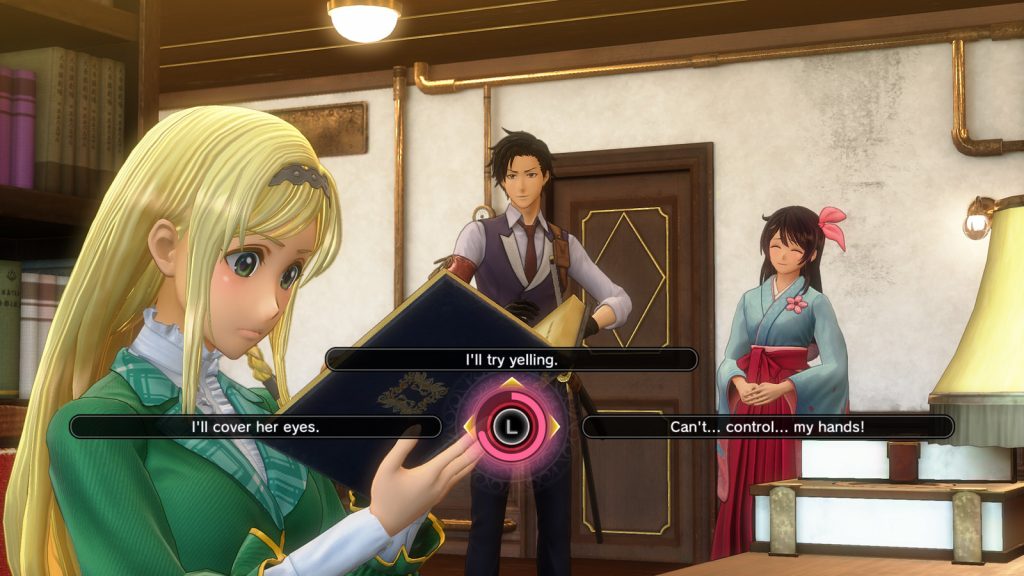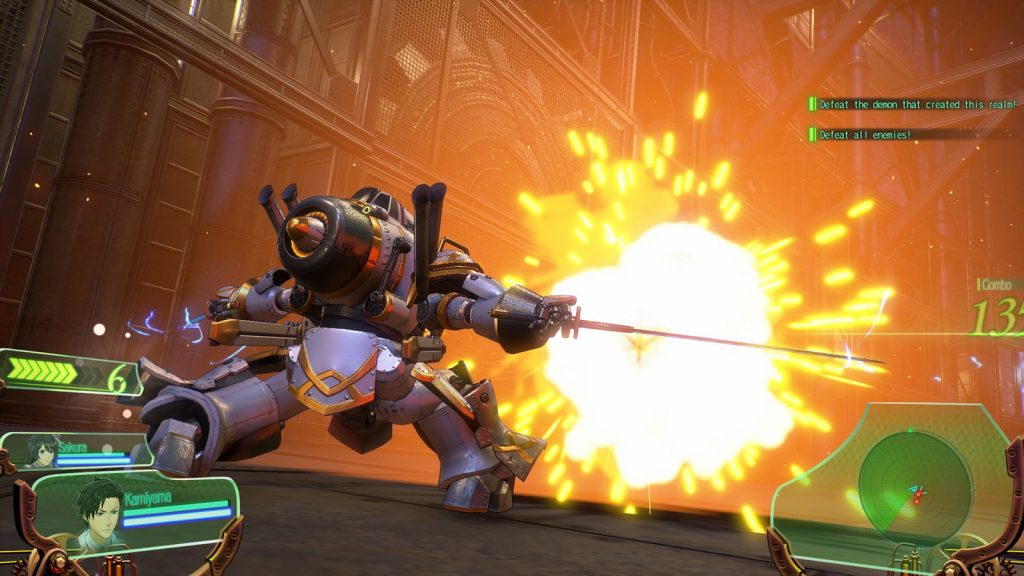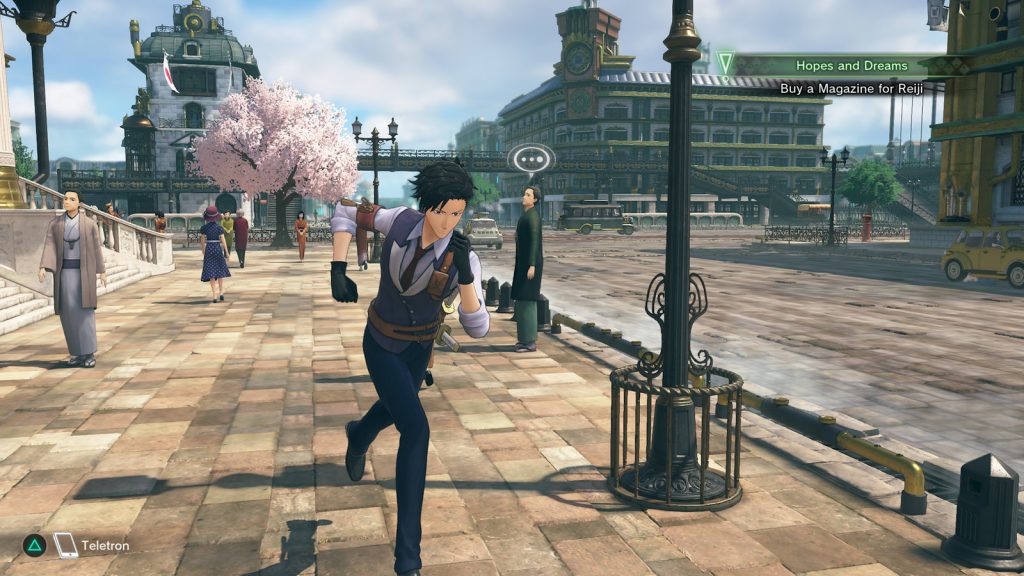Powerful demons are wreaking havoc across Tokyo! Who better to protect the populace than… the local theatre troop? Problem is they’re just as bad at fighting as they are at acting. Now it’s up to Seijuro Kamiyama to whip them into shape, somehow. Through the power of love, and some big mechs, maybe they can make their dreams come true.
Sakura Wars is one of Sega’s longest running franchises, albeit one that never really received much in the way of Western releases. The original games are a mishmash between a tactical RPG, visual novel, and a dating sim. Which is a bizarre smoothy in and of itself, yet was enough to garner a loyal cult following on both sides of the pacific. New Sakura Wars, or just Sakura Wars as its known in the West, is a soft reboot of the series, with new characters, as well as a change from tactical to real time brawler combat.
The game is set in an alternate steam punk 1940s, about 15 years after the events of the first game. Naval ensign Seijuro Kamiyama has been selected to captain the Imperial Combat Revue, a group of warrior-thespians tasked with defending Tokyo from demon attacks. Kamiyama’s old childhood friend Sakura Amamiya is a member, so he’s looking forward to seeing her again. There’s only one problem. The Imperial Combat Revue: Flower Division are a shadow of their former selves. So terrible at their jobs that the Japanese government has even threatened to cut their funding. At least they can act, right? Well… Kamiyama might have his work cut out for him.
Most of the game is spent in the visual novel portion. You’ll walk around the Imperial Theatre, and the nearby Ginza district, doing side quests for the game’s cast of quirky characters. The core mechanic here is the LIPS system, where you’ll have to enter timed dialogue prompts. Choosing the right prompt will net you trust with your team members, which results in status buffs for the combat portion. Choosing rude or pervy options can result in some pretty hilarious moments, but costs trust. Basically keep your ladies happy if you want to win, which is a good strategy in life as it is in the game.

Your core group has five playable slash dateable characters. Sakura, as mentioned before, is a swordswoman and Kamiyama’s childhood friend. This is your canon romance choice. Rounding out the cast are Hatsuho, a fiery redhead who speaks like Goro Majima, Claris, a Luxembourgish noblewoman with a mysterious past, Azami, a ninja in training, and Anastasia, a world renowned actress from Greece. Most of your interactions with them are scripted, as are the “dates”.. You pretty much have to romance all of them as part of the story. Though whomever you have the highest trust with will ultimately be who you end up with. So be sure to play your cards right, you charming son of a gun.
The story itself is quite outlandish, like its 90s shonen melodrama roots. You wouldn’t think a slice of life would go together with a action plot about robots fighting demons. Yet I can’t help but get invested in it. The characters are all likeable and you really want to see things work out for them, even when suspension of disbelief gets stretched to its limits.
The rest of the game is spent in combat, using mech suits called mugen. You get sucked into Shadow Tokyo, or compete in a competition with the other Combat Revues as part of the story. Shadow Tokyo missions are a straight run through a linear level, with a boss fight at the end. The Games are a team based event where you have to kill more enemies than the AI within a time limit to win. There are also raids, where you pair up with one of the girls for shorter combat missions against various enemies.

Combat here is easily the weakest part of the game. There are basically two combos, a basic dodge with bullet time, and most fights are pretty straight forward, requiring little in the way of strategy. Shadow Tokyo usually pairs you up with a single girl as part of the story. The Games let you choose two team mates, so there is a little more strategizing here. Kamiyama’s mech will typically be your default. It dual wields katanas, and is good for speedy players. Sakura’s single katana is your balanced team member. Hatsuho has a giant hammer, for your heavy hitter. Claris and Anastasia focus on ranged attacks, while Azami is a mix of speed and ranged. Ultimately, I don’t find any mixes to be objectively superior, so just choose who you like, or who makes more sense for the story at that point. You can also switch between Kamiyama and your other teammates by tapping on L1 during battle, for moments when you need to mix things up. Enemy variety here is okay. Overall, I found the combat felt stiff, and almost a bit of an afterthought. Passible, but again, nothing special.
There’s one more game mode: Koi-koi Wars. This is a popular Japanese card game played with a Hanafuda deck. Which if you know your gaming history, is what Nintendo got their start making. I suppose you could describe it as a fishing game, where you build hands, with certain hands being worth more points. You play different characters and get PSN trophies for unlocking and beating them all. Aside from that, it has no impact on the main game.
On to the technical portion of the show.
Graphics here are pretty solid. The world of steam punk Toyko has a great art style, with lots of little greebles that make its world pop. That world isn’t very big mind you. There’s only a handful of locations you visit, and a lot of assets are reused in the combat sections. But it feels big enough for what it’s trying to convey, with good attention to detail. I really love its overall design, that kind of gives you a homy 1940s feeling, without you know, that other stuff Japan was up to at the time. Of course this is an alternate history.

Character too look excellent. Again, it’s very shonen, with your buxom waifus and what not. But there’s a lot of colourful designs here that gives even NPCs a ton of personality. The main characters were designed by Tite Kubo, the artist behind the popular manga Bleach. Many guest artists also lent a hand, including Yukiko Horiguchi (K-On!), BUNBUN (Sword Art Online), Fumikane Shimada (Girls und Panzer), Noizi Ito (Haruhi Suzumiya), Shigenori Soejima (Persona), and even Ken Sugimori (Pokémon). Manga fans should be able to quickly spot who designed who.
For audio, the sound track is charming and orchestral, if a tad limited. You’ll hear the same tunes repeated over and over. But they’re good enough not to be annoying, even if they do sometimes stick in your head (like that theme song). I don’t think it does anything beyond similar JRPGs, like you’re not getting anything on par with Final Fantasy or Xenoblade, but it’s still decent. Voice acting too is also pretty good, as far as I can tell. There’s no English dub, only subtitles, so you’ll only be hearing the Japanese VAs. If you’ve played the older Yakuza games, you’ll be used to this experience. Which, it’s worth noting, the same localization team did the subtitles.
From a performance standpoint, this isn’t exactly a game that pushes the PS4 hardware, but then again it doesn’t really need to. You can expect a 1080/30p experience here. Frame rates were solid throughout and I didn’t encounter any bugs. There don’t seem to be any PS4 Pro / PS5 enhancements that I’m aware of.
Sakura Wars is a game I saw pop up in a few action-JRPG recommendation videos. Honestly, while it’s not perfect, I did thoroughly enjoy my time with it. We don’t see silly games like this anymore, especially from Western studios. It’s just good, stupid fun with plenty of fanservice. Sometimes that’s all you need. And if you didn’t get enough from the game, there is, naturally, an anime. Yes, I did watch it. It takes place as a direct sequel to the game, and again I found it thoroughly enjoyable. It uses the same VAs and the same studio that did the cutscenes. Oddly enough, it did get an English dub.
Sakura Wars is a PS4 exclusive title, and not available on other platforms.





